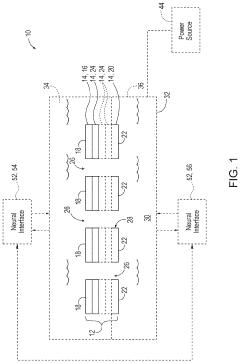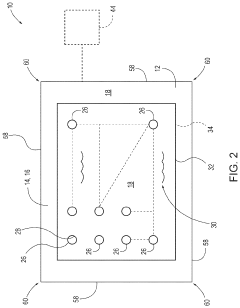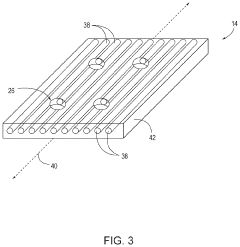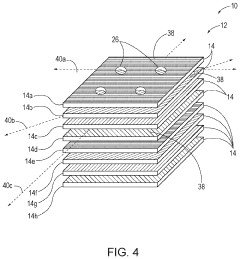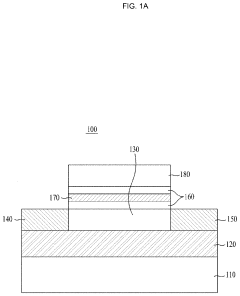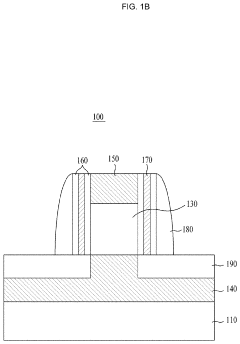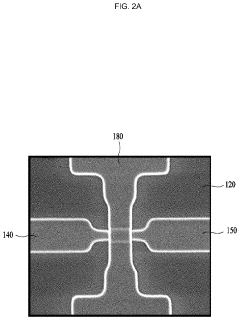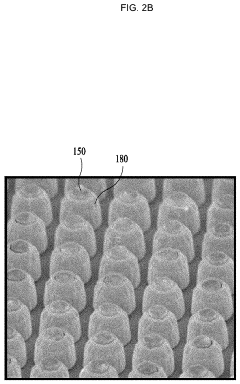What Role Does Regulation Play in Neuromorphic Material Advancement
OCT 27, 20259 MIN READ
Generate Your Research Report Instantly with AI Agent
Patsnap Eureka helps you evaluate technical feasibility & market potential.
Neuromorphic Materials Regulatory Landscape and Development Goals
Neuromorphic computing represents a paradigm shift in computational architecture, drawing inspiration from the human brain's neural networks to create more efficient and adaptive systems. The regulatory landscape surrounding neuromorphic materials is complex and multifaceted, shaped by considerations ranging from safety and environmental impact to ethical implications and intellectual property rights.
Currently, regulations governing neuromorphic materials exist in a fragmented state across different jurisdictions. In the United States, the Food and Drug Administration (FDA) oversees neuromorphic materials used in medical applications, while the Environmental Protection Agency (EPA) regulates potential environmental impacts of novel materials. The European Union has implemented the REACH (Registration, Evaluation, Authorization and Restriction of Chemicals) framework, which applies to many materials used in neuromorphic computing, particularly those containing rare earth elements or potentially hazardous compounds.
The development goals for neuromorphic materials are ambitious and multidimensional. Primary objectives include creating materials with enhanced energy efficiency, reduced latency, and improved adaptability compared to traditional computing architectures. Researchers aim to develop materials capable of mimicking synaptic plasticity, facilitating learning and memory functions similar to biological neural networks.
A significant development goal involves scaling neuromorphic systems from laboratory demonstrations to commercially viable products. This transition necessitates regulatory frameworks that balance innovation with safety considerations. Current regulatory gaps particularly affect novel materials like memristors, phase-change materials, and spintronic devices, which often fall between established regulatory categories.
International standardization represents another critical development goal. Organizations such as the IEEE and ISO are working to establish common standards for neuromorphic materials and systems, which would facilitate global research collaboration and commercial deployment. These standards aim to address performance metrics, safety parameters, and interoperability requirements.
Ethical considerations form an integral part of the regulatory landscape. As neuromorphic systems approach capabilities that mimic aspects of human cognition, questions arise regarding privacy, autonomy, and potential misuse. Regulatory frameworks are evolving to address these concerns, with initiatives like the EU's AI Act potentially encompassing advanced neuromorphic systems.
The trajectory of neuromorphic material development is increasingly influenced by sustainability goals. Regulations promoting circular economy principles are driving research toward materials with reduced environmental footprints, recyclability, and decreased reliance on scarce resources. This regulatory pressure is reshaping research priorities and material selection criteria across the field.
Currently, regulations governing neuromorphic materials exist in a fragmented state across different jurisdictions. In the United States, the Food and Drug Administration (FDA) oversees neuromorphic materials used in medical applications, while the Environmental Protection Agency (EPA) regulates potential environmental impacts of novel materials. The European Union has implemented the REACH (Registration, Evaluation, Authorization and Restriction of Chemicals) framework, which applies to many materials used in neuromorphic computing, particularly those containing rare earth elements or potentially hazardous compounds.
The development goals for neuromorphic materials are ambitious and multidimensional. Primary objectives include creating materials with enhanced energy efficiency, reduced latency, and improved adaptability compared to traditional computing architectures. Researchers aim to develop materials capable of mimicking synaptic plasticity, facilitating learning and memory functions similar to biological neural networks.
A significant development goal involves scaling neuromorphic systems from laboratory demonstrations to commercially viable products. This transition necessitates regulatory frameworks that balance innovation with safety considerations. Current regulatory gaps particularly affect novel materials like memristors, phase-change materials, and spintronic devices, which often fall between established regulatory categories.
International standardization represents another critical development goal. Organizations such as the IEEE and ISO are working to establish common standards for neuromorphic materials and systems, which would facilitate global research collaboration and commercial deployment. These standards aim to address performance metrics, safety parameters, and interoperability requirements.
Ethical considerations form an integral part of the regulatory landscape. As neuromorphic systems approach capabilities that mimic aspects of human cognition, questions arise regarding privacy, autonomy, and potential misuse. Regulatory frameworks are evolving to address these concerns, with initiatives like the EU's AI Act potentially encompassing advanced neuromorphic systems.
The trajectory of neuromorphic material development is increasingly influenced by sustainability goals. Regulations promoting circular economy principles are driving research toward materials with reduced environmental footprints, recyclability, and decreased reliance on scarce resources. This regulatory pressure is reshaping research priorities and material selection criteria across the field.
Market Analysis for Brain-Inspired Computing Technologies
The brain-inspired computing technology market is experiencing significant growth, driven by advancements in neuromorphic materials and architectures that mimic biological neural systems. Current market projections indicate the global neuromorphic computing market will reach approximately $8.9 billion by 2025, with a compound annual growth rate exceeding 20% between 2020-2025. This remarkable expansion reflects increasing demand for energy-efficient computing solutions capable of handling complex AI workloads.
Market segmentation reveals diverse application areas gaining traction. The healthcare sector represents the largest market share, with neuromorphic technologies enabling breakthroughs in medical imaging, disease diagnosis, and brain-computer interfaces. Autonomous vehicles constitute another rapidly growing segment, where real-time processing capabilities of neuromorphic systems provide crucial advantages for object recognition and decision-making under uncertain conditions.
Consumer electronics manufacturers are increasingly incorporating neuromorphic elements in edge devices, responding to consumer demand for smarter, more responsive products with enhanced privacy features through on-device processing. The defense sector also demonstrates substantial investment in neuromorphic technologies for applications ranging from threat detection to autonomous systems.
Regional analysis indicates North America currently leads market development, hosting major research institutions and technology companies pioneering neuromorphic solutions. However, Asia-Pacific represents the fastest-growing region, with substantial investments from countries like China, Japan, and South Korea in both research infrastructure and commercial applications. European markets show particular strength in specialized neuromorphic applications for industrial automation and precision manufacturing.
Market dynamics are significantly influenced by regulatory frameworks governing neuromorphic material development. Regulations affecting rare earth elements and specialized semiconductor materials directly impact supply chains and manufacturing costs. Additionally, data privacy regulations shape application development pathways, particularly in healthcare and consumer applications where neuromorphic systems process sensitive information.
Investment patterns reveal increasing corporate and government funding directed toward neuromorphic research, with venture capital investments in neuromorphic startups exceeding $1.2 billion in 2021 alone. This represents a threefold increase compared to 2018 figures, indicating growing market confidence in commercial viability.
Customer adoption analysis shows varying penetration rates across industries, with early adopters primarily in research institutions and technology-forward enterprises. Mainstream commercial adoption faces challenges including integration complexity with existing systems, talent shortages in neuromorphic engineering, and concerns regarding regulatory compliance across different jurisdictions.
Market segmentation reveals diverse application areas gaining traction. The healthcare sector represents the largest market share, with neuromorphic technologies enabling breakthroughs in medical imaging, disease diagnosis, and brain-computer interfaces. Autonomous vehicles constitute another rapidly growing segment, where real-time processing capabilities of neuromorphic systems provide crucial advantages for object recognition and decision-making under uncertain conditions.
Consumer electronics manufacturers are increasingly incorporating neuromorphic elements in edge devices, responding to consumer demand for smarter, more responsive products with enhanced privacy features through on-device processing. The defense sector also demonstrates substantial investment in neuromorphic technologies for applications ranging from threat detection to autonomous systems.
Regional analysis indicates North America currently leads market development, hosting major research institutions and technology companies pioneering neuromorphic solutions. However, Asia-Pacific represents the fastest-growing region, with substantial investments from countries like China, Japan, and South Korea in both research infrastructure and commercial applications. European markets show particular strength in specialized neuromorphic applications for industrial automation and precision manufacturing.
Market dynamics are significantly influenced by regulatory frameworks governing neuromorphic material development. Regulations affecting rare earth elements and specialized semiconductor materials directly impact supply chains and manufacturing costs. Additionally, data privacy regulations shape application development pathways, particularly in healthcare and consumer applications where neuromorphic systems process sensitive information.
Investment patterns reveal increasing corporate and government funding directed toward neuromorphic research, with venture capital investments in neuromorphic startups exceeding $1.2 billion in 2021 alone. This represents a threefold increase compared to 2018 figures, indicating growing market confidence in commercial viability.
Customer adoption analysis shows varying penetration rates across industries, with early adopters primarily in research institutions and technology-forward enterprises. Mainstream commercial adoption faces challenges including integration complexity with existing systems, talent shortages in neuromorphic engineering, and concerns regarding regulatory compliance across different jurisdictions.
Regulatory Challenges in Neuromorphic Material Development
The regulatory landscape surrounding neuromorphic materials presents significant challenges for researchers, manufacturers, and commercial entities. Current regulations were largely established before the emergence of these advanced materials, creating a misalignment between existing frameworks and the unique properties of neuromorphic technologies. This regulatory gap has resulted in uncertainty regarding safety standards, testing protocols, and approval processes specifically tailored to brain-inspired computing materials.
A primary regulatory challenge stems from the interdisciplinary nature of neuromorphic materials, which often fall between traditional regulatory categories. These materials may simultaneously qualify as electronic components, novel nanomaterials, and potentially even biological interfaces, creating jurisdictional confusion among regulatory bodies. The FDA, EPA, OSHA, and international counterparts frequently struggle to determine which agency should take primary oversight responsibility, leading to regulatory redundancies or dangerous gaps in supervision.
Material classification presents another significant hurdle. Many neuromorphic materials incorporate novel compounds or structures with properties that existing regulatory frameworks cannot adequately categorize. For instance, self-organizing memristive systems that exhibit emergent behaviors challenge traditional risk assessment methodologies designed for static materials with predictable properties. This classification difficulty impedes the establishment of clear safety thresholds and testing requirements.
Ethical considerations further complicate the regulatory landscape. As neuromorphic materials increasingly mimic biological neural systems, questions arise regarding appropriate boundaries and safeguards. Current regulations provide minimal guidance on ethical implications of brain-inspired computing materials, particularly concerning privacy, autonomy, and potential consciousness-like properties in advanced systems. The absence of ethical frameworks specifically addressing neuromorphic technologies creates uncertainty for developers navigating compliance requirements.
International regulatory harmonization represents another major challenge. Different regions have adopted varying approaches to neuromorphic material regulation, creating a fragmented global landscape. While the European Union has implemented precautionary principles through initiatives like REACH (Registration, Evaluation, Authorization and Restriction of Chemicals), the United States has generally favored innovation-friendly regulatory environments. This lack of international standardization increases compliance costs for companies operating globally and potentially slows technological advancement.
Intellectual property protection within regulatory frameworks also presents difficulties. The novel nature of neuromorphic materials often challenges existing patent classification systems, creating uncertainty regarding IP protection. This regulatory ambiguity can discourage investment in research and development, particularly for smaller entities without resources to navigate complex international IP landscapes while simultaneously addressing varied regulatory requirements.
A primary regulatory challenge stems from the interdisciplinary nature of neuromorphic materials, which often fall between traditional regulatory categories. These materials may simultaneously qualify as electronic components, novel nanomaterials, and potentially even biological interfaces, creating jurisdictional confusion among regulatory bodies. The FDA, EPA, OSHA, and international counterparts frequently struggle to determine which agency should take primary oversight responsibility, leading to regulatory redundancies or dangerous gaps in supervision.
Material classification presents another significant hurdle. Many neuromorphic materials incorporate novel compounds or structures with properties that existing regulatory frameworks cannot adequately categorize. For instance, self-organizing memristive systems that exhibit emergent behaviors challenge traditional risk assessment methodologies designed for static materials with predictable properties. This classification difficulty impedes the establishment of clear safety thresholds and testing requirements.
Ethical considerations further complicate the regulatory landscape. As neuromorphic materials increasingly mimic biological neural systems, questions arise regarding appropriate boundaries and safeguards. Current regulations provide minimal guidance on ethical implications of brain-inspired computing materials, particularly concerning privacy, autonomy, and potential consciousness-like properties in advanced systems. The absence of ethical frameworks specifically addressing neuromorphic technologies creates uncertainty for developers navigating compliance requirements.
International regulatory harmonization represents another major challenge. Different regions have adopted varying approaches to neuromorphic material regulation, creating a fragmented global landscape. While the European Union has implemented precautionary principles through initiatives like REACH (Registration, Evaluation, Authorization and Restriction of Chemicals), the United States has generally favored innovation-friendly regulatory environments. This lack of international standardization increases compliance costs for companies operating globally and potentially slows technological advancement.
Intellectual property protection within regulatory frameworks also presents difficulties. The novel nature of neuromorphic materials often challenges existing patent classification systems, creating uncertainty regarding IP protection. This regulatory ambiguity can discourage investment in research and development, particularly for smaller entities without resources to navigate complex international IP landscapes while simultaneously addressing varied regulatory requirements.
Current Regulatory Frameworks for Novel Computing Materials
01 Memristive materials for neuromorphic computing
Memristive materials are key components in neuromorphic computing systems that mimic the behavior of biological synapses. These materials can change their resistance based on the history of applied voltage or current, enabling them to store and process information simultaneously. Various types of memristive materials, including metal oxides and phase-change materials, are being developed to create artificial neural networks with high energy efficiency and computational capabilities.- Memristive materials for neuromorphic computing: Memristive materials are used in neuromorphic computing to mimic the behavior of biological synapses. These materials can change their resistance based on the history of applied voltage or current, enabling them to store and process information simultaneously. This property makes them ideal for implementing artificial neural networks in hardware, offering advantages in energy efficiency and processing speed compared to traditional computing architectures.
- Phase-change materials for neuromorphic applications: Phase-change materials can rapidly switch between amorphous and crystalline states, exhibiting different electrical resistances in each state. This property enables them to function as artificial synapses in neuromorphic systems, allowing for multi-level storage capabilities that mimic the variable connection strengths of biological neural networks. These materials offer advantages in terms of scalability, switching speed, and endurance for neuromorphic computing implementations.
- Organic and polymer-based neuromorphic materials: Organic and polymer-based materials are emerging as promising candidates for neuromorphic computing due to their flexibility, biocompatibility, and tunable properties. These materials can be engineered to exhibit synaptic behaviors such as spike-timing-dependent plasticity and short-term/long-term potentiation. Their solution processability allows for low-cost fabrication methods, making them attractive for large-scale neuromorphic systems and bioelectronic interfaces.
- 2D materials for neuromorphic devices: Two-dimensional materials such as graphene, transition metal dichalcogenides, and hexagonal boron nitride offer unique properties for neuromorphic computing applications. Their atomically thin nature provides excellent electrostatic control, while their tunable electronic properties enable the implementation of various synaptic functions. These materials can be integrated into vertical heterostructures to create compact neuromorphic devices with low power consumption and high integration density.
- Neuromorphic algorithms and architectures: Beyond materials, neuromorphic computing relies on specialized algorithms and architectures that efficiently implement neural network functions in hardware. These approaches include spiking neural networks, reservoir computing, and brain-inspired learning rules that can be realized using various neuromorphic materials. The integration of these algorithms with appropriate materials enables systems that can perform complex cognitive tasks with significantly lower power consumption than conventional computing approaches.
02 Phase-change materials for neuromorphic applications
Phase-change materials exhibit reversible transitions between amorphous and crystalline states, making them suitable for neuromorphic computing applications. These materials can store multiple resistance states, enabling multi-level memory capabilities that mimic synaptic plasticity in biological neural networks. The ability to rapidly switch between states with low energy consumption makes phase-change materials promising candidates for energy-efficient neuromorphic systems.Expand Specific Solutions03 Two-dimensional materials for neuromorphic devices
Two-dimensional materials such as graphene, transition metal dichalcogenides, and hexagonal boron nitride offer unique properties for neuromorphic computing applications. Their atomically thin structure provides excellent electronic properties, flexibility, and scalability. These materials can be engineered to exhibit synaptic behaviors like spike-timing-dependent plasticity and short-term/long-term potentiation, making them suitable for brain-inspired computing architectures.Expand Specific Solutions04 Neuromorphic algorithms and hardware implementations
Advanced algorithms and hardware architectures are being developed to optimize the performance of neuromorphic materials. These include spiking neural networks, reservoir computing, and various learning algorithms that can be implemented in physical neuromorphic systems. Hardware implementations focus on integrating neuromorphic materials into efficient computing architectures that can perform complex cognitive tasks while minimizing energy consumption and maximizing parallel processing capabilities.Expand Specific Solutions05 Organic and biomimetic materials for neuromorphic systems
Organic and biomimetic materials offer unique advantages for neuromorphic computing, including biocompatibility, flexibility, and self-healing properties. These materials can be engineered to mimic various aspects of biological neural systems, such as ion transport mechanisms and synaptic plasticity. Polymer-based memristors, protein-based memory devices, and other biomimetic approaches are being explored to create more efficient and biologically realistic neuromorphic computing systems.Expand Specific Solutions
Key Stakeholders in Neuromorphic Material Regulation
Neuromorphic material advancement is currently in an early growth phase, with the regulatory landscape playing a crucial role in shaping its trajectory. The global market is expanding steadily, projected to reach significant scale as applications in neural interfaces and brain-computer integration develop. Regulatory frameworks are evolving to balance innovation with safety concerns, particularly in medical applications. Leading institutions like Tsinghua University, Johns Hopkins University, and companies such as H. Lundbeck A/S and Autonomix Medical are navigating complex approval pathways while contributing to standards development. Collaborative efforts between academic centers (University of Copenhagen, Nanjing University) and industry players (TDK Corp., Genentech) are establishing best practices, while regulatory harmonization across jurisdictions remains a challenge for this emerging technology domain.
Tsinghua University
Technical Solution: Tsinghua University has developed a regulatory-integrated approach to neuromorphic materials through their Brain-Inspired Computing Research Center. Their technology focuses on neuromorphic chips that incorporate China's emerging regulatory frameworks for AI systems directly into hardware design. Their materials feature built-in compliance verification systems that continuously monitor operation against regulatory requirements. Tsinghua has pioneered a "regulation-aware" development methodology where materials are designed to adapt to changing regulatory landscapes without requiring complete redesign. Their neuromorphic systems include configurable governance parameters that can be adjusted to meet different regulatory requirements across global markets. The university has established a specialized regulatory science division focused specifically on neuromorphic materials, creating standardized approaches to compliance that can accelerate development while maintaining safety and ethical standards. Their approach demonstrates how regulatory considerations can drive innovation rather than constrain it.
Strengths: Strong alignment with China's emerging AI regulatory frameworks; efficient compliance verification systems; adaptable design approach that can respond to regulatory changes. Weaknesses: Potential challenges with international regulatory acceptance; focus on Chinese regulatory standards may limit global applicability.
The Board of Regents of The University of Texas System
Technical Solution: The University of Texas System has developed neuromorphic materials with built-in regulatory compliance features through their Advanced Materials Research Institute. Their approach focuses on creating neuromorphic computing architectures that incorporate regulatory constraints directly into material design. Their technology includes neuromorphic chips with programmable regulatory boundaries that prevent operation outside approved parameters. The UT System has pioneered a dual-track development approach where materials are simultaneously optimized for performance and regulatory compliance, reducing time to market. Their neuromorphic systems include transparent operation modes that facilitate regulatory inspection and verification, addressing key concerns about "black box" AI systems. The university has established partnerships with regulatory agencies to develop testing standards specifically for neuromorphic materials, creating clearer pathways to approval for novel applications in critical infrastructure, healthcare, and transportation sectors.
Strengths: Comprehensive approach that balances innovation with compliance; strong relationships with US regulatory bodies; transparent design philosophy that facilitates regulatory approval. Weaknesses: Complex implementation requirements; potential performance trade-offs to maintain regulatory compliance features.
Critical Patents and Compliance Requirements for Neuromorphic Materials
Neuromorphic architectures, actuators, and related methods
PatentPendingUS20220215240A1
Innovation
- The development of neuromorphic architectures using carbon fiber reinforced polymer (CFRP) materials with distributed nodes and electrochemical fluids to enable local processing, incorporating shape memory alloys for actuators, allowing for decentralized and robust processing without reliance on external central units.
Single transistor capable of using both neuron and synaptic devices, and a neuromorphic system using it
PatentInactiveUS20210097380A1
Innovation
- A single transistor with a floating body layer for neuron operation and a charge storage layer for synaptic operation is used, allowing for co-integration of neuron and synaptic devices on the same plane, reducing the need for wire bonding and improving integration, energy consumption, and speed.
International Regulatory Harmonization Efforts
The global landscape of neuromorphic materials development is significantly influenced by varying regulatory frameworks across different regions. Recognizing this challenge, several international initiatives have emerged to harmonize regulatory approaches, creating a more conducive environment for research and commercialization of neuromorphic technologies.
The International Organization for Standardization (ISO) has established technical committees focused on developing unified standards for neuromorphic computing materials and systems. These standards address critical aspects such as material characterization, performance metrics, and safety parameters, providing a common language for researchers and manufacturers across borders.
Similarly, the IEEE Standards Association has launched working groups dedicated to neuromorphic engineering, with particular emphasis on materials specifications and testing protocols. These efforts aim to create globally recognized benchmarks that can facilitate international collaboration and technology transfer in the neuromorphic domain.
The OECD has been instrumental in developing policy frameworks that balance innovation with responsible development of advanced materials, including those used in neuromorphic systems. Their guidelines encourage regulatory convergence while respecting regional priorities and governance structures.
Bilateral agreements between major research hubs have also contributed significantly to regulatory harmonization. The EU-US Trade and Technology Council, for instance, has established dedicated tracks for emerging technologies that include neuromorphic materials, working toward mutual recognition of safety assessments and certification procedures.
In the Asia-Pacific region, initiatives like the APEC Regulatory Cooperation Advancement Mechanism provide platforms for aligning approaches to novel materials regulation, including those with neuromorphic applications. These forums facilitate knowledge exchange on regulatory best practices and emerging challenges.
The International Neuromorphic Engineering Consortium, comprising academic institutions, industry leaders, and regulatory bodies from multiple countries, serves as a neutral ground for developing consensus-based regulatory recommendations. Their framework proposals have been increasingly adopted by national regulatory agencies, creating pathways toward greater international alignment.
Despite these positive developments, challenges remain in harmonizing regulations for dual-use neuromorphic materials that may have both civilian and military applications. Varying national security concerns and export control regimes continue to create regulatory divergence that impacts international research collaboration and technology commercialization.
The International Organization for Standardization (ISO) has established technical committees focused on developing unified standards for neuromorphic computing materials and systems. These standards address critical aspects such as material characterization, performance metrics, and safety parameters, providing a common language for researchers and manufacturers across borders.
Similarly, the IEEE Standards Association has launched working groups dedicated to neuromorphic engineering, with particular emphasis on materials specifications and testing protocols. These efforts aim to create globally recognized benchmarks that can facilitate international collaboration and technology transfer in the neuromorphic domain.
The OECD has been instrumental in developing policy frameworks that balance innovation with responsible development of advanced materials, including those used in neuromorphic systems. Their guidelines encourage regulatory convergence while respecting regional priorities and governance structures.
Bilateral agreements between major research hubs have also contributed significantly to regulatory harmonization. The EU-US Trade and Technology Council, for instance, has established dedicated tracks for emerging technologies that include neuromorphic materials, working toward mutual recognition of safety assessments and certification procedures.
In the Asia-Pacific region, initiatives like the APEC Regulatory Cooperation Advancement Mechanism provide platforms for aligning approaches to novel materials regulation, including those with neuromorphic applications. These forums facilitate knowledge exchange on regulatory best practices and emerging challenges.
The International Neuromorphic Engineering Consortium, comprising academic institutions, industry leaders, and regulatory bodies from multiple countries, serves as a neutral ground for developing consensus-based regulatory recommendations. Their framework proposals have been increasingly adopted by national regulatory agencies, creating pathways toward greater international alignment.
Despite these positive developments, challenges remain in harmonizing regulations for dual-use neuromorphic materials that may have both civilian and military applications. Varying national security concerns and export control regimes continue to create regulatory divergence that impacts international research collaboration and technology commercialization.
Ethical and Safety Considerations in Neuromorphic Technology
The rapid advancement of neuromorphic materials and technologies raises significant ethical and safety considerations that demand careful attention from researchers, industry stakeholders, and regulatory bodies. As these technologies increasingly mimic human brain functions, questions about privacy, autonomy, and potential misuse become paramount. Neuromorphic systems that can learn, adapt, and potentially make decisions raise fundamental questions about responsibility and accountability when these systems operate in critical applications.
Privacy concerns are particularly acute as neuromorphic technologies may eventually interface directly with human neural systems or process highly sensitive personal data. The potential for unauthorized access to neural data or the manipulation of brain-computer interfaces presents unprecedented risks to individual privacy and mental autonomy. Regulatory frameworks must evolve to address these novel challenges while balancing innovation with protection.
Safety considerations extend beyond data security to the physical implementation of neuromorphic materials. Many advanced neuromorphic systems utilize novel materials with unknown long-term environmental and health impacts. The potential toxicity of nanomaterials, rare earth elements, and other components used in neuromorphic computing requires thorough assessment and monitoring protocols. Regulations governing material safety and disposal must adapt to these emerging technologies.
The dual-use potential of neuromorphic technologies presents another critical concern. While designed primarily for beneficial applications like medical diagnostics or efficient computing, these technologies could be repurposed for surveillance, autonomous weapons systems, or other applications with significant ethical implications. International cooperation on export controls and usage guidelines becomes essential to prevent misuse while enabling beneficial innovation.
Transparency and explainability represent additional challenges in neuromorphic systems. As these technologies increasingly rely on self-learning algorithms and emergent behaviors, ensuring that their decision-making processes remain understandable and accountable becomes technically difficult yet ethically necessary. Regulatory approaches must balance the need for innovation with requirements for system transparency, particularly in high-risk applications.
The potential for neuromorphic technologies to exacerbate existing social inequalities must also be addressed. Access to advanced neuromorphic technologies may be limited by economic factors, potentially widening technological divides between different populations. Regulatory frameworks should consider how to promote equitable access to the benefits of neuromorphic advancements while mitigating potential harms across diverse communities.
Privacy concerns are particularly acute as neuromorphic technologies may eventually interface directly with human neural systems or process highly sensitive personal data. The potential for unauthorized access to neural data or the manipulation of brain-computer interfaces presents unprecedented risks to individual privacy and mental autonomy. Regulatory frameworks must evolve to address these novel challenges while balancing innovation with protection.
Safety considerations extend beyond data security to the physical implementation of neuromorphic materials. Many advanced neuromorphic systems utilize novel materials with unknown long-term environmental and health impacts. The potential toxicity of nanomaterials, rare earth elements, and other components used in neuromorphic computing requires thorough assessment and monitoring protocols. Regulations governing material safety and disposal must adapt to these emerging technologies.
The dual-use potential of neuromorphic technologies presents another critical concern. While designed primarily for beneficial applications like medical diagnostics or efficient computing, these technologies could be repurposed for surveillance, autonomous weapons systems, or other applications with significant ethical implications. International cooperation on export controls and usage guidelines becomes essential to prevent misuse while enabling beneficial innovation.
Transparency and explainability represent additional challenges in neuromorphic systems. As these technologies increasingly rely on self-learning algorithms and emergent behaviors, ensuring that their decision-making processes remain understandable and accountable becomes technically difficult yet ethically necessary. Regulatory approaches must balance the need for innovation with requirements for system transparency, particularly in high-risk applications.
The potential for neuromorphic technologies to exacerbate existing social inequalities must also be addressed. Access to advanced neuromorphic technologies may be limited by economic factors, potentially widening technological divides between different populations. Regulatory frameworks should consider how to promote equitable access to the benefits of neuromorphic advancements while mitigating potential harms across diverse communities.
Unlock deeper insights with Patsnap Eureka Quick Research — get a full tech report to explore trends and direct your research. Try now!
Generate Your Research Report Instantly with AI Agent
Supercharge your innovation with Patsnap Eureka AI Agent Platform!
